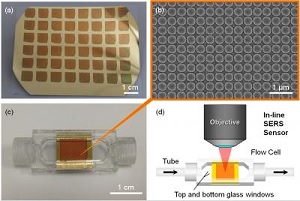 |
| The nano-dome surface allows laser light to scatter in a characteristic way for different kinds of chemicals or drugs.--Courtesy of the University of Illinois |
To improve the delivery of intravenous drugs, researchers at the University of Illinois have developed a computerized system that not only determines the exact dosage but also identifies the contents of a fluid in the IV line in real time. Drugs the system can identify include morphine, methadone, and phenobarbital, as well as sedatives and multiple sclerosis drugs.
Safety concerns about intravenous drugs often relate to human error, which can lead to incorrect dosage as well as the delivery of the wrong drug or wrong combination of drugs. To address the latter problem, the researchers used a process called Surface-Enhanced Raman Scattering (SERS) to identify chemicals within a medication at nanoscale sensitivity, according to a release from The Optical Society.
The researchers incorporated a surface made up of "nano-domes" on the inside lining of the IV tubing. These tiny structures capture the light shone from a laser light, and the computer identifies which chemicals are present by the way the light scatters off the surfaces of each bump. Furthermore, such linings are inexpensively produced, according to the release, on flexible plastic surfaces via a molding process.
The team, led by Micro and Nanotechnology Laboratory interim director Brian Cunningham, designed the system to be able to identify drugs at concentrations 100 times lower than current systems and to identify multiple drugs at a time. They hope to be able to identify combinations of up to 10 drugs delivered at once, and are looking to commercialize the system.
"Up to 61% of all life-threatening errors during hospitalization are associated with IV drug therapy," Cunningham said in a statement. "So for all the really good things hospitals can do, the data show that mistakes can occasionally happen."
Cunningham and his team of student researchers will present their work at The Optical Society's Annual Meeting, Frontiers in Optics in Orlando, FL, in October.
- here's the release